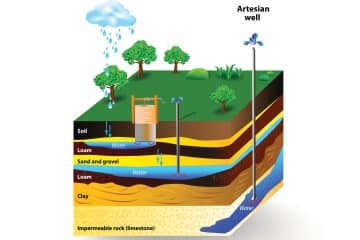
Sand & Gravel vs Bedrock – Understanding Aquifer Solutions for Your Water Supply
Author: Jennifer Lambert, PG – Director of Environmental Services NH
A good water supply needs both sufficient quality and quantity – which can be complicated in New England. The first choice for water supply wells is overburden material, particularly sand and gravel. A “clean” (minimal finer-grained material) sand and gravel aquifer is a great source for large quantities of water. However, here in New England, we frequently encounter deposits that include finer material, which fills in the smaller pore spaces and reduces the amount of water that can be stored in a given volume and also the speed at which groundwater can move.
A sand and gravel aquifer can also be highly sensitive to contamination, however, because the same properties that allow for high flow for a drinking water well also allow contaminants to migrate with groundwater to that drinking water well. In addition to point sources of contamination (such as gas stations with potential fuel spills or hazardous waste sites), agriculture and densely populated residential areas with leach fields also have the potential to impact water supply with microbial contamination and excess fertilizer (the Walkerton, Ontario E. coli outbreak is an extreme example of this). Another issue for wells drawing from sand and gravel aquifers is the potential for them to tap into and deplete water from local wetlands and surface water bodies, causing potential damage to sensitive habitats.
Because a sand and gravel aquifer is both an excellent water source in terms of water production and may be impacted by (or may impact) near-surface conditions, these materials have been studied and identified. New Hampshire’s Granit geographic information system (GIS) has a layer identifying stratified drift (sand and gravel) aquifers, and Massachusetts’ Oliver GIS system identifies high yield and medium yield aquifers. These can be used as a starting point for determining if a sand and gravel water supply well should be considered.
Bedrock water supplies are more complicated, as most of the water will flow through specific fractures or fracture networks. Here in New England, our bedrock is frequently “mashed up” (you can see this on many of the road cuts, particularly southern portions of I-93 in New Hampshire), and therefore major water-bearing fractures are difficult to predict. Hydrogeologists use signs of fractures in the landscape (photolineaments) and surface geophysics to try and identify likely fracture zones, but the only way to confirm that a fracture or fracture zone will actually produce sufficient water is to drill test wells. Many of the residential wells in New England are bedrock wells because of the relative scarcity of sufficiently thick sand and gravel deposits; in this case, the driller will keep going until sufficient water is reached because there is not enough room to move to another area. This means that residential bedrock wells can be hundreds of feet deep.
Bedrock wells are generally well insulated from surface contaminants (although this is not true for all wells; shallow contamination can short-circuit the overburden and occur at surprising depths via near-vertical fractures) compared to sand and gravel wells. However, the bedrock itself can cause other issues: radon and naturally occurring metals such as iron, arsenic, and manganese that can both impact health and foul plumbing.
As our population increases and more people move into formerly rural areas, we will need to find additional water sources. Groundwater from both overburden (sand and gravel) and bedrock will likely need to be part of the solution, so it is important to consider both resources and their advantages and disadvantages in future planning.